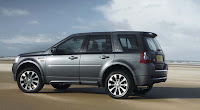Kia Soulster Concept, 2009
>> Saturday, May 14, 2011
Kia Soulster Concept, 2009
The open-air concept of Kia Soulster is a variation of the highly anticipated Soul.
The Kia Soulster delivers something new, intriguing and relevant to today's buyers - a fun, affordable convertible for active people who like to share good times with friends.
The two-door concept with roadster roots, the brightly colored Soul'r yellow Soulster projects a hip industrial look with screw borders, reminiscent of a rivet design found on a fighter jet. The windshield is shortened for a sportier and hunkered down appearance. A two-piece top enables passengers to expose the front and back seating areas independently, using elbow-grease technology. The roll bar serves a dual purpose and includes a place for the slider tracks, while providing protection not found in traditional convertibles.
Kia Soulster has a tough but refined character with a unique face .
The toughness is expressed through details like the anodized skid-pad insert, which matches the fender vents, roll bar header and wheels.
Kia Soulster's attitude incorporates lighting that shines through with an amber glow under the headlamps. The side vents, side-mirror turn signals, unique LED headlamps, fog and tail lamps incorporate blue shades.
The energetic, distinctive look carries from front to rear with dual chrome exhaust and polished aluminum exhaust tips featuring carbon-fiber interior sleeves. The large 19-inch, five-spoke aluminum alloy wheels perfect the Kia Soulster's appearance. Regardless of Soulster being viewed from front, back or side, it offers innovative perspectives derived from the original Soul.
Inside Out
Kia Soulster takes even more progressive variations from Soul beginning with the new four-passenger seating design, a diversion from Soul's five-passenger arrangement, lending spacious versatility for long summer weekends. The surprisingly flexible Kia Soulster provides real seating for two in the front with comfortable seating for two more adults in the back. Fold-flat passenger and rear seats combined with ample headroom make this the perfect car for social outings outdoors and on the beach with friends. Making basic features hot, its crank-up windows are a purposefully key interior design element as are the dashboard-integrated audio speakers.
Adding to the edgy design scheme, the non-floor-mounted cantilevered seats project the illusion of being suspended in space when viewed from the side allowing for increased rear legroom. Storage compartments below each of the fold-flat rear seats, offer room for myriad cargo needs. In addition to the spacious cargo area, dual storage compartments also can be found in the rear and underneath the cargo hold area.
All Revved Up
With young buyers in mind, Kia Soulster offers an agile, smooth and spirited ride. As with its Soul cousin, Soulster's can be made available with a myriad of engine choices depending upon each market's needs. A 1.6-liter, four-cylinder engine is mated to a five-speed manual transmission, which produces approximately 120 horsepower. For those looking for a little more power, a 2.0-liter four-cylinder engine is available with either the five-speed manual or a four-speed automatic transmission, producing approximately 140 horsepower. Fuel economy for both engines is estimated at 30 or more miles per gallon. Other markets might choose the 1.6-liter four-cylinder engine producing 124 horsepower or a 1.6-liter turbodiesel.
Read more...
The Kia Soulster delivers something new, intriguing and relevant to today's buyers - a fun, affordable convertible for active people who like to share good times with friends.
The two-door concept with roadster roots, the brightly colored Soul'r yellow Soulster projects a hip industrial look with screw borders, reminiscent of a rivet design found on a fighter jet. The windshield is shortened for a sportier and hunkered down appearance. A two-piece top enables passengers to expose the front and back seating areas independently, using elbow-grease technology. The roll bar serves a dual purpose and includes a place for the slider tracks, while providing protection not found in traditional convertibles.
Kia Soulster has a tough but refined character with a unique face .
The toughness is expressed through details like the anodized skid-pad insert, which matches the fender vents, roll bar header and wheels.
Kia Soulster's attitude incorporates lighting that shines through with an amber glow under the headlamps. The side vents, side-mirror turn signals, unique LED headlamps, fog and tail lamps incorporate blue shades.
The energetic, distinctive look carries from front to rear with dual chrome exhaust and polished aluminum exhaust tips featuring carbon-fiber interior sleeves. The large 19-inch, five-spoke aluminum alloy wheels perfect the Kia Soulster's appearance. Regardless of Soulster being viewed from front, back or side, it offers innovative perspectives derived from the original Soul.
Inside Out
Kia Soulster takes even more progressive variations from Soul beginning with the new four-passenger seating design, a diversion from Soul's five-passenger arrangement, lending spacious versatility for long summer weekends. The surprisingly flexible Kia Soulster provides real seating for two in the front with comfortable seating for two more adults in the back. Fold-flat passenger and rear seats combined with ample headroom make this the perfect car for social outings outdoors and on the beach with friends. Making basic features hot, its crank-up windows are a purposefully key interior design element as are the dashboard-integrated audio speakers.
Adding to the edgy design scheme, the non-floor-mounted cantilevered seats project the illusion of being suspended in space when viewed from the side allowing for increased rear legroom. Storage compartments below each of the fold-flat rear seats, offer room for myriad cargo needs. In addition to the spacious cargo area, dual storage compartments also can be found in the rear and underneath the cargo hold area.
All Revved Up
With young buyers in mind, Kia Soulster offers an agile, smooth and spirited ride. As with its Soul cousin, Soulster's can be made available with a myriad of engine choices depending upon each market's needs. A 1.6-liter, four-cylinder engine is mated to a five-speed manual transmission, which produces approximately 120 horsepower. For those looking for a little more power, a 2.0-liter four-cylinder engine is available with either the five-speed manual or a four-speed automatic transmission, producing approximately 140 horsepower. Fuel economy for both engines is estimated at 30 or more miles per gallon. Other markets might choose the 1.6-liter four-cylinder engine producing 124 horsepower or a 1.6-liter turbodiesel.

























































